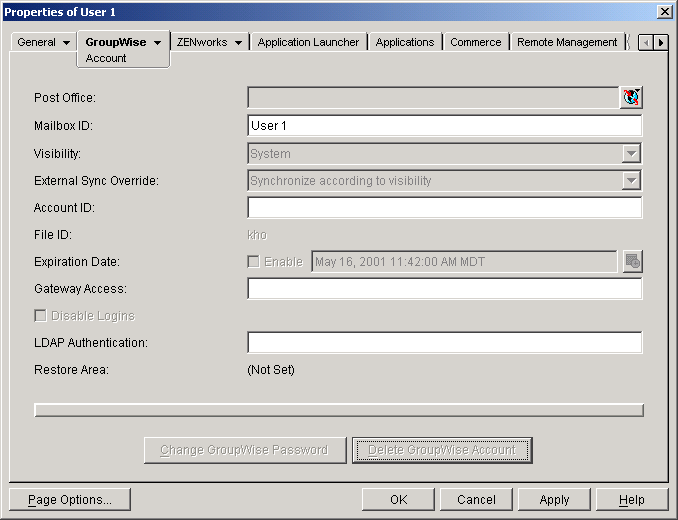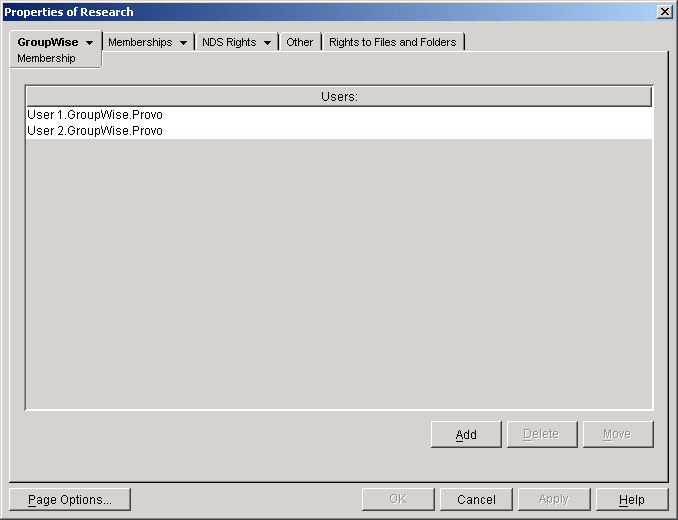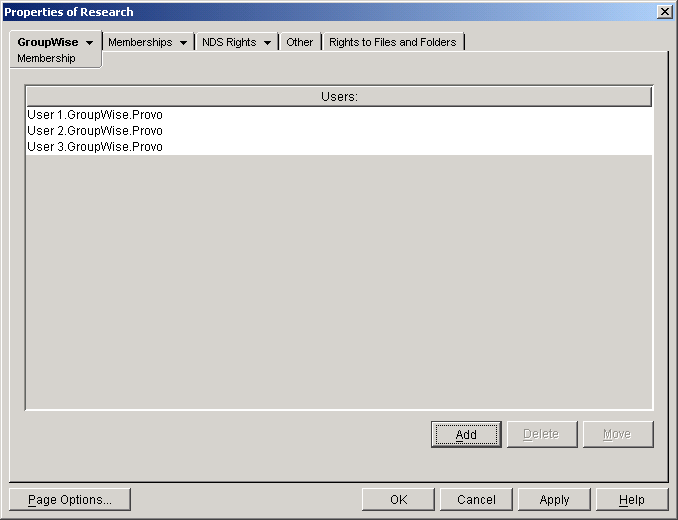Creating GroupWise Accounts for eDirectory Users
Depending on your needs, you can choose from the following methods to create GroupWise accounts for eDirectory users:
- Creating a Single GroupWise Account: You can create a GroupWise account for a single eDirectory user by editing the GroupWise information on his or her User object. This method lets you create the GroupWise account on any post office, select the GroupWise user ID, and configure optional GroupWise information. It provides the most flexibility in creating a user's GroupWise account.
- Creating Multiple GroupWise Accounts: You can create GroupWise accounts for multiple eDirectory users by editing the membership information on a Post Office object. This method allows you to quickly add multiple users to the same post office at one time. However, you cannot select the user's GroupWise user ID; instead, the user's eDirectory username is automatically used as his or her GroupWise user ID. In addition, to configure other optional GroupWise information for a user, you need to modify each User object.
- Creating GroupWise Accounts by Importing Users: You can import information from ASCII-delimited text files.
- Using a Template to Create GroupWise Accounts: You can create a template to apply to new eDirectory User objects you create. The template can be configured to automatically assign the user to a post office.
Creating a Single GroupWise Account
To create a GroupWise account for an eDirectory user:
-
In ConsoleOne, right-click the User object, then click Properties.
-
Click GroupWise > Account to display the Account page.

-
Fill in the following fields:
Post Office: Select the post office where you want the user's mailbox created.
Mailbox ID: The Mailbox ID (also referred to as the GroupWise user ID) defaults to the eDirectory username. You can change it if necessary.
IMPORTANT: GroupWise mailbox IDs cannot contain periods. If the eDirectory username contains one or more periods, you must provide a mailbox ID that does not contain periods.
-
Click Apply to create the account.
You must create the account by clicking Apply (or OK) before you can modify any of the other fields, including the GroupWise password.
-
If desired, modify any of the following optional fields:
Visibility: Select the level at which you want the user to be visible in the Address Book. System enables the user to be visible to all users in your GroupWise system. Domain enables the user to be visible to all users in the same domain as the user. Post Office enables the user to be visible to all users on the same post office as the user. Setting the visibility level to None means that no users will see the user in the Address Book. However, even if the user is not displayed in the Address Book, other users can send messages to the user by typing the user's ID (mailbox ID) in a message's To field.
External Sync Override: This option applies only if your GroupWise system links to and synchronizes with an external system.
Select the Synchronize According to Visibility setting if you want the user information to be provided to the other system only if the user's visibility is set to System.
Select the Synchronize Regardless of Visibility setting if you always want the user information provided to the other system regardless of the user's visibility level.
Select the Don't Synchronize Regardless of Visibility setting if you never want the user information provided to the other system.
Account ID: This option applies only if you have a GroupWise gateway that supports accounting. For more information about gateway accounting, see your GroupWise gateway documentation.
File ID: This three-letter ID is randomly generated and is non-editable. It is used for various internal purposes within the GroupWise system, including ensuring that files associated with the user have unique names.
Expiration Date: If you want the user's GroupWise account to no longer work after a certain date, specify the expiration date. This date applies to the user's GroupWise account only; it is independent of the eDirectory account expiration date (User object > Restrictions tab > Login Restrictions page).
Gateway Access: This option applies only if you have GroupWise gateways that support access restrictions. For more information, see your gateway documentation.
Disable Logins: Select this option to prevent the user from accessing his or her GroupWise mailbox.
LDAP Authentication: This option applies only if you are using LDAP to authenticate users to GroupWise (see Providing LDAP Authentication for GroupWise Users) and the LDAP server is not the Novell LDAP server. If this is the case, enter the user's LDAP authentication ID.
Restore Area: This field applies only if you are using the GroupWise backup and restore features. If so, this field indicates the location where the user's mailbox is being backed up. For details, see Restoring GroupWise Databases from Backup.
Change GroupWise Password: Click this option to assign a password to the user's GroupWise account or change the current password. The user will be prompted for this password each time he or she logs in to GroupWise.
To be able to skip this option by setting a default password, see Establishing a Default Password for All New GroupWise Accounts.
Delete GroupWise Account: Click this option to delete the user's GroupWise account. This includes the user's mailbox and all items in the mailbox. The user's eDirectory account is not affected.
-
Click Apply to save the changes.
-
Click GroupWise > General > Identification to display the user's current eDirectory information.
This information will appear in the GroupWise Address Book, as described in Address Book. If you keep private information in the Description field of the User object, you can prevent this information from appearing the GroupWise Address Book. See Preventing the User Description Field from Displaying in the Address Book.
-
Make sure that the user's eDirectory information is current, then click OK.
Creating Multiple GroupWise Accounts
If you have multiple eDirectory users who will have GroupWise accounts on the same post office, you can use the Post Office object's Membership page to quickly add the users and create their accounts. Each user's GroupWise user ID will be the same as his or her eDirectory username.
To create GroupWise accounts for multiple eDirectory users:
-
In ConsoleOne, right-click the Post Office object, then click Properties.
-
Click GroupWise > Membership to display the Membership page.

-
Click Add, select the eDirectory user you want to add to the post office, then click OK to add the user to the post office's membership list.
By default, the user's eDirectory username is used as the GroupWise ID.
IMPORTANT: GroupWise IDs cannot contain periods. If the any of the eDirectory usernames contain periods, you must provide GroupWise IDs that do not contain periods on the GroupWise Account page of each User object.

-
Repeat Step 3 to create additional GroupWise accounts in the post office.
-
When finished, click OK to save the changes.
Creating GroupWise Accounts by Importing Users
You can quickly create multiple GroupWise users by importing ASCII-delimited text files created by the GroupWise Export utility or by a third-party export. The text files provide the eDirectory and GroupWise attributes necessary for creating users. For information about using the GroupWise Import utility, see Import. For information about using the GroupWise Export utility, see Export.
Using a Template to Create GroupWise Accounts
If you frequently create new users, you might want to create Template objects with the necessary GroupWise properties. This makes creating a new eDirectory user with GroupWise access a one-step process. However, you cannot use a Template object to give GroupWise properties to existing eDirectory users.
The steps to create a template with GroupWise properties include assigning the post office and setting up directory rights. Because a user can have membership in only one post office, a different template should be created for each existing post office. Further, for each post office, a template can be created for different categories of users, such as secretarial, accounting, administrative, human resources, development, sales, and manufacturing.
After one template has been created with eDirectory properties and post office directory rights, you can use it to quickly create templates for subsequent post offices.
Creating a Template
-
In ConsoleOne, right-click the Organizational Unit object where you want to create the Template object, then click New > Object to display the New Object dialog box.
Templates should be placed in the same organizational unit where they will be used because the browser first lists any templates in the current context. The template will also inherit rights from the container the template is created in, further simplifying its setup.
-
In the Class list, select Template, then click OK to display the New Template dialog box.
-
Enter a name that describes the purpose for which the template will be used.
-
If you want to base the template on another Template or User object, select Use Template or User, then browse to and select the desired Template or User object.
-
Select Define Additional Properties.
-
Click Create to display the properties pages for the Template object.
-
Click GroupWise > Information.
-
Fill in the following fields:
Post Office: Select the post office the user will be assigned to.
Visibility: Select the level at which the user will be visible in the Address Book. System enables the user to be visible to all users in your GroupWise system. Domain enables the user to be visible to all users in the same domain as the user. Post Office enables the user to be visible to all users on the same post office as the user. Setting the visibility level to None means that no users will see the user in the Address Book. However, even if the user is not displayed in the Address Book, other users can send messages to the user by typing the user's ID (mailbox ID) in a message's To field.
Account ID: This field supports accounting for GroupWise gateways. For more information about gateway accounting, see your gateway documentation.
Expiration Date: Use this to set a date when the user's account will expire. The user will not be able to access the account after that date. For more information, see Expiring a GroupWise Account.
Gateway Access: This is used to grant or restrict access to some GroupWise gateways. See your gateway documentation to determine if this field applies.
-
Modify information on any of the other tabs to configure the template, then click OK to save the template changes.
Creating a User Account from a Template
-
In ConsoleOne, right-click the container where you want to create a new eDirectory user, then click New > User.
-
Enter a Name, Surname, and Unique ID (all three are required).
-
Select the Use Template option, then browse to and select the template you want applied to this user.
-
Modify any of the other options you want.
-
Click OK to create the user's eDirectory and GroupWise accounts.